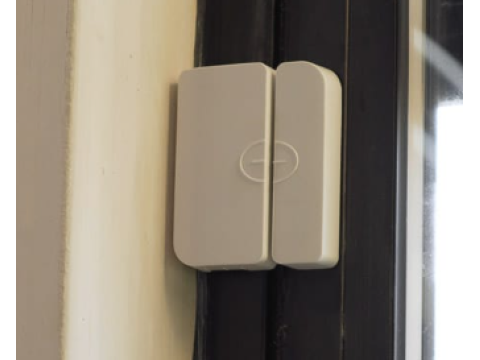Why Your Door Needs a Dedicated Alarm Sensor
In the United States, doors remain one of the most common points of unauthorized entry. When protecting any property—be it a home, office, or warehouse—securing your front door or other external doors is crucial. In alarm-system planning, professionals consider two primary intrusion methods:
- Opening
- Breaking (Forcing)
Whether an intruder picks a lock, breaks the lock cylinder, or cuts the lock, the alarm system must catch the door being rotated on its hinges far enough for someone to pass through. However, sensors that detect door movement alone won’t catch attempts to break the door panel itself (e.g., drilling through or smashing the main area). Below, we break down how specialized door sensors address both “opening” and “break-in” threats.
Detecting Door Opening
Alarm systems use two main approaches to register that a door has been opened:
End-of-Line (Mechanical) Switches
- A mechanical plunger or lever is depressed when the door is closed. Opening the door releases this switch, opening or closing an electrical contact in the alarm circuit.
- Less common today due to simpler alternatives.
Magnetic Contact Sensors (Reed Switches)
- A magnet is placed on the door, while a reed switch (hermetic contact) is mounted on the frame (or vice versa).
- When the door moves, the magnet shifts away from the switch, triggering the alarm circuit.
- This method is easy, reliable, and widely used for all kinds of doors—metal, wood, or plastic.
Proper Installation Tips for Magnetic Contacts
- Maintain the Correct Gap: Each model specifies a maximum operational distance (often 0.4–1 inch). If the door and frame separate beyond this gap, the reed switch changes state (open/closed).
- Position the Sensor Close to the Latch Side: Typically no more than 8 inches (20 cm) from the door’s vertical edge, ensuring the alarm triggers before the gap is wide enough for someone to slip through.
- Consider Sabotage Tactics: A skilled intruder might attempt to place a separate magnet during the brief moment the door is partially opened. Or, they could attach a powerful magnet from the outside to trick the sensor.
- Concealed or Tamper-Resistant sensors can significantly reduce this risk—ideal for higher-security installations or where you want to preserve the door’s aesthetics.
Detecting Door Break-In Attempts
Sometimes it’s easier for an intruder to force or break the door rather than unlock it. This is especially likely with:
- Lightweight doors, including many plastic or thin wooden types.
- Heavily fortified doors, where lock picking or sawing is exceedingly difficult, but the panel itself (in certain areas) can be breached.
Common Sensor Types for “Break” Detection
Omnibus/Wire Sensors (Legacy Method)
- Involves running a thin, continuous wire across the panel or surface. Any break in the circuit triggers the alarm.
- Reliable but labor-intensive and visually intrusive—rarely used in modern systems.
Shock-Contact Sensors
- Placed directly on the door to register a single strong impact, like a forceful hit.
- Sensitive to any abrupt mechanical shock, which can lead to false alarms if the door is accidentally banged.
Vibration Sensors
- Detect repeated drilling, sawing, or pounding on the door.
- Also prone to false alarms if the door experiences routine jolts (e.g., heavy traffic, slamming).
Installation Concerns for Break-In Sensors
- Sensor Vulnerability: With door-mounted devices, an intruder can potentially tamper with or destroy the sensor if no additional protective measures are in place.
- False Alarms: Vibrations from loud noises or incidental contact might trigger the detector if not calibrated correctly.
- Cable Flexing: You must run wires from the door panel to the frame using a flexible conduit or “door loop,” another point of potential wear or sabotage.
Because of these drawbacks, break-in sensors generally see more use in restricted areas, like vault doors or storerooms containing high-value items. The everyday user typically prefers “passage detection” (e.g., a motion detector behind the door) to trigger the alarm the moment someone steps inside, if the door is forced open.
Alternative: Passage (Motion) Detection
Another way to secure a door is by detecting anyone actually moving through the doorway or just inside it:
- Curtain (Surface) Motion Sensors: Create a narrow “sheet” of coverage along the door’s interior side.
- Volumetric Motion Detectors: Monitor the entire room. If someone enters, they trigger the sensor.
Pros:
- The system doesn’t care how the door is opened or broken—any crossing into the secured zone sets off the alarm.
Cons:
- No Early Warning: The alarm only fires once the intruder is already inside.
- Some security professionals mitigate this by adding a second door (solid or barred) between the intruder and your main interior, placing a motion sensor in the gap.
Best Practices & Final Thoughts
Choosing the right door sensor depends on factors like the door’s build, the likelihood of forced entry vs. lock manipulation, and the property’s overall security strategy. In many American homes, a magnetic contact sensor suffices as a reliable first alert, especially when paired with an interior motion detector for enhanced coverage. However, high-risk scenarios—like commercial storefronts, data centers, or warehouse storage areas—may demand additional layers (break sensors, curtain detectors, or reinforced door designs).
- Combine Tactics:
- Magnetic contact for opening detection.
- Surface or volumetric motion sensor for backup coverage if someone forcibly breaches the door panel.
- Consider Concealed Sensors:
- Minimizes sabotage risk and preserves door appearance.
- Match Material & Sensor Type:
- Choose a sensor rated for your door type (metal, wood, PVC).
- Think About Tampering:
- If sabotage is a concern, hide or shield the sensor or use advanced tamper switches.
By addressing both opening and break-in possibilities, you create a robust, layered defense around your doors. For more detailed advice, high-quality sensors, and full alarm solutions, visit safsale.com—your go-to source for residential and commercial security systems.

